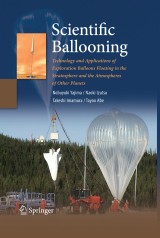Details

Scientific Ballooning
Technology and Applications of Exploration Balloons Floating in the Stratosphere and the Atmospheres of Other Planets|
181,89 € |
|
| Verlag: | Springer |
| Format: | |
| Veröffentl.: | 21.04.2009 |
| ISBN/EAN: | 9780387097275 |
| Sprache: | englisch |
| Anzahl Seiten: | 214 |
Dieses eBook enthält ein Wasserzeichen.
Beschreibungen
<P>The aim of this book is to introduce scientific ballooning to the many people who are interested in the use of balloons for scientific applications. The book offers a basic understanding of the engineering details and the scientific research giving rise to balloon activities going on today. Above all, the book will serve as a guidebook for young scientists and researchers seeking to become involved in space science and technology by participating in balloon projects. The book deals with three types of balloons: large stratospheric balloons used for scientific purposes, rubber balloons used for aerological observations, and planetary balloons to be used in the atmospheres of other planets. The book provides many figures and photographs, and offers a systematic description of balloon technologies and related matters from historical background to current research topics. The contents include a theoretical discussion of ballon shape design, analysis and synthesis of flight dynamics, actual launching procedure, flight operations, and typical applications of ballooning in various scientific fields. Detailed meteorological descriptions, especially of the Earth's stratosphere and the atmosphere of other planets, are provided for investigating actual flight behavior.</P>
Engineering Fundamentals of Balloons.- Stratospheric Balloons.- Planetary Ballooning.- The Future of Scientific Ballooning.
<P>The subject of this book is stratospheric balloons used for scientific observations and for the development of space technology and balloons that are used for aerological observations. These balloons attain flight altitudes more than three times those of passenger planes. They transport payloads ranging from several hundred kilograms up to several tons into the earth’s stratosphere. The density of the atmosphere at these altitudes is less than 1% that at the earth’s surface. In addition, as part of planetary exploration, this book includes planetary balloons sent to float over other planets that have atmospheres, such as Mars and Venus. The general term used to describe these sorts of activities is scientific ballooning.</P>
<P>Although the flights of stratospheric balloons used for various scientific observations and technological experiments do not take place in the void of space, stratospheric balloons may be placed in the same fields as rockets and satellites, namely space science and technology. This, of course, goes without saying for planetary balloons that are transported into outer space on space vehicles. Organizations that conduct research and development, and that launch and perform operations with this type of scientific ballooning are usually associated with each country’s meteorological organizations and space research and development organizations.</P>
<P>Stratospheric balloons are giant pressurized membrane structures that float in the thin atmosphere of the stratosphere. Their volumes range from a few tens of thousands of cubic meters up to several hundred thousand cubic meters. Their flight characteristics are governed by complex relationships of fluid dynamics and thermodynamics. For planetary balloons, various atmospheric conditions that differ from those on the ground also come into effect. Consequently, performing systematic engineering design and analysis is a prerequisite for constructing and launching balloons. Aerologicalknowledge of the atmosphere is indispensable for conducting a flight. Such a foundation also ensures safety and reliability during flights. The aim of this book is to systematically describe the engineering aspects associated with scientific ballooning.</P>
<P>Although the flights of stratospheric balloons used for various scientific observations and technological experiments do not take place in the void of space, stratospheric balloons may be placed in the same fields as rockets and satellites, namely space science and technology. This, of course, goes without saying for planetary balloons that are transported into outer space on space vehicles. Organizations that conduct research and development, and that launch and perform operations with this type of scientific ballooning are usually associated with each country’s meteorological organizations and space research and development organizations.</P>
<P>Stratospheric balloons are giant pressurized membrane structures that float in the thin atmosphere of the stratosphere. Their volumes range from a few tens of thousands of cubic meters up to several hundred thousand cubic meters. Their flight characteristics are governed by complex relationships of fluid dynamics and thermodynamics. For planetary balloons, various atmospheric conditions that differ from those on the ground also come into effect. Consequently, performing systematic engineering design and analysis is a prerequisite for constructing and launching balloons. Aerologicalknowledge of the atmosphere is indispensable for conducting a flight. Such a foundation also ensures safety and reliability during flights. The aim of this book is to systematically describe the engineering aspects associated with scientific ballooning.</P>
First book to provide a thorough account of scientific ballooning aimed at scientists and engineers in related fields Proposes solutions to problems concerning conventional balloon design and manufacturing for improved balloon strength independent of balloon size Presents advanced design concepts for realization of a large super pressure balloon, which has been a challenge in balloon engineering for half a century Includes supplementary material: sn.pub/extras

















